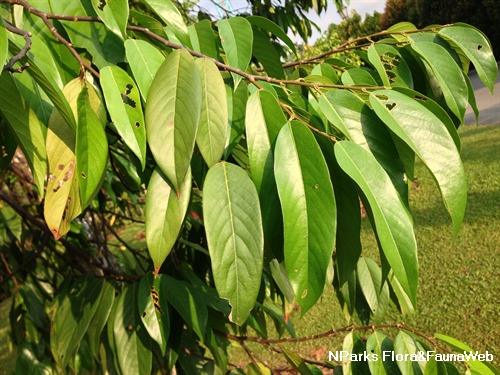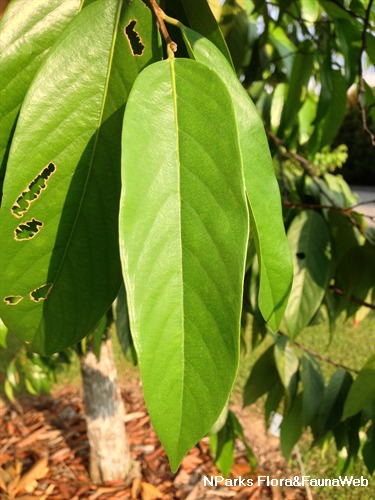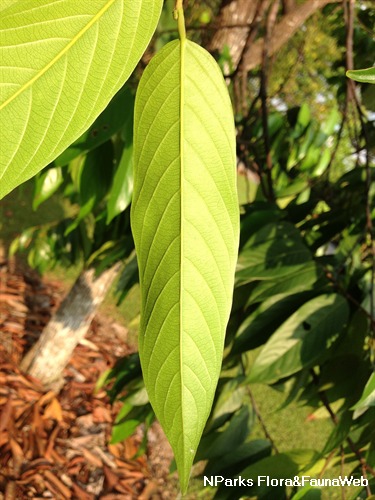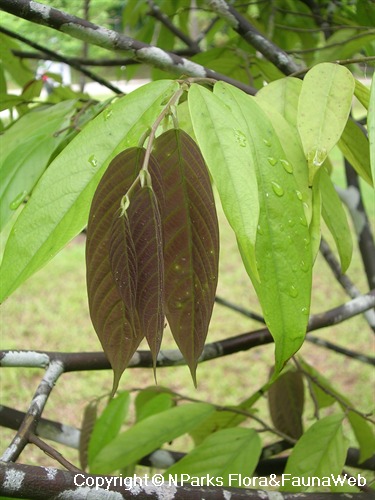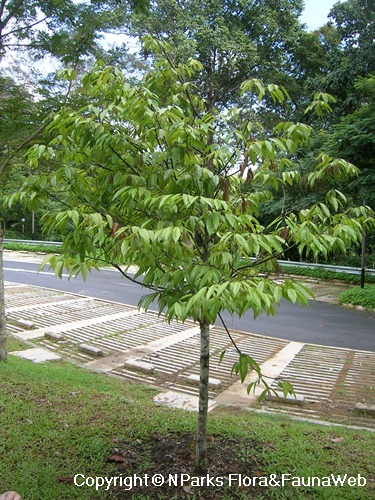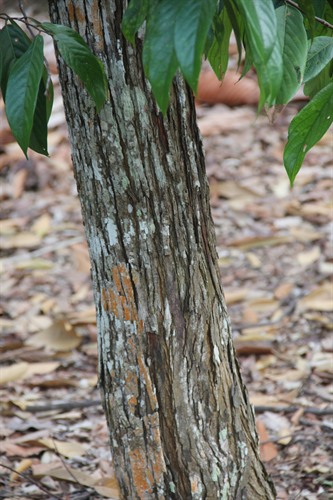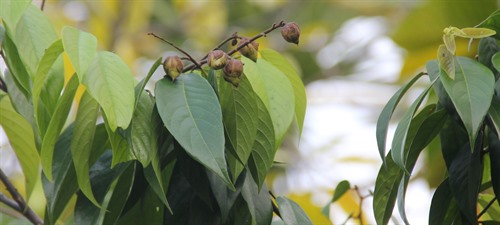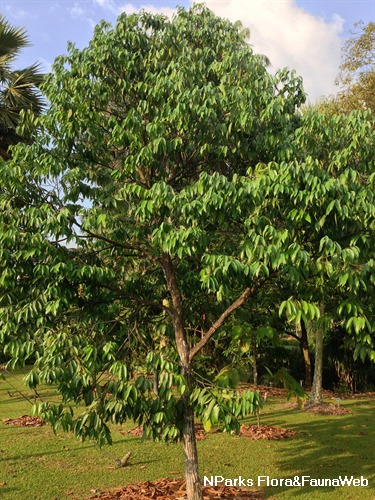
Back
Neobalanocarpus heimii (King) P.S.Ashton
| Family Name: | Dipterocarpaceae |
| Synonyms: | Balanocarpus heimii King, Balanocarpus wrayi King, Pierrea penangiana F.Heim ex Brandis |
| Common Name: | Chengal, Chengai, Penak, Chengai Tembaga, Chengai Batu, Changi Tree |
Neobalanocarpus heimii, also known as Chengal, is a native tree which can reach up to 60 m tall. It produces acorn-like fruit which are dispersed by mammals or sloping terrain. The tree is a source of resin and good quality timber which is highly resistant to decay and termites.
Name
Classifications and Characteristics
| Plant Division | Angiosperms (Flowering Seed Plants) (Dicotyledon) |
|---|---|
| Plant Growth Form | Tree |
| Lifespan (in Singapore) | Perennial |
| Mode of Nutrition | Autotrophic |
| Plant Shape | Irregular |
| Maximum Height | 60 m |
Biogeography
| Native Distribution | Thailand, Peninsular Malaysia and Singapore. |
|---|---|
| Native Habitat | Terrestrial (Primary Rainforest, Secondary Rainforest) |
| Preferred Climate Zone | Tropical |
| Local Conservation Status | Native to Singapore (Presumed Nationally Extinct (NEx)) |
Description and Ethnobotany
| Growth Form | It is a tree, up to 60 m, with prominent large buttress. Bark is irregularly longitudinally fissured and peels off in long scales. |
|---|---|
| Foliage | Leaves are green, leathery and arranged alternately. Each leaf is lanceolate to sickle-shaped (falcate) (7 – 17 cm long and 2.3 – 5 cm wide). The leaf base is unequal, wedge shaped (cuneate) to obtuse while leaf tip is tapering (up to 1.5 cm long). Each leaf has 9 – 12 pairs of secondary veins. Both the midrib and secondary veins are sunken above and prominent on the underside of the leaf. The petiole is short (0.5 – 1 cm long). The stipules are straped-shaped (lorate) and fall off early. Young leaves emerge bronze and gradually turn green as they mature. |
| Flowers | Flowers occur in a cluster as a panicle inflorescence at the terminal or axillary position. Inflorescence is single-branched, reaching up to 9 cm long, and comprises of up to 7 flowers. All the flowers on the branch face the same direction (secund). Flower is small, creamy white to pale greenish yellow. Each flower has 15 stamens with tapering filaments and linear-oblong anthers. The ovary is glabrous and ovoid with long thread-like style. |
| Fruit | The fruit is woody and acorn-like. The nut is oblanceolate to cylindrical, reaching up to 5.5 cm long and 2.5 cm wide. The calyx lobes are small (2 cm long and 1.8 cm wide) and adpressed to the base of the nut, making it seem wingless. |
| Habitat | It is found in rainforests, along slopes and in valleys, up to 1000 m altitude. |
| Associated Fauna | Flowers are pollinated by insects. Seeds are dispersed by animals or rolling down slopes. |
| Cultivation | It can be propagated by seed. |
| Etymology | Greek Neobalanocarpus, means new acorn fruit which refers to the fruit resemblance to acorn. Latin heimii, commemorates Frédéric Louis Heim (1869 – 1962), a French researcher on Dipterocarpaceae. |
| Ethnobotanical Uses | Timber & Products: The tree produces clear colourless or pale-yellow resinous exudate when injured. It is a source of resin and good quality timber which is highly resistant to decay and termites. |
Landscaping Features
| Landscaping | It is suitable for parks. |
|---|---|
| Landscape Uses | Parks & Gardens |
Fauna, Pollination and Dispersal
| Pollination Method(s) | Biotic (Fauna) |
|---|---|
| Seed or Spore Dispersal | Abiotic |
Plant Care and Propagation
| Light Preference | Full Sun, Semi-Shade |
|---|---|
| Water Preference | Moderate Water |
| Plant Growth Rate | Slow |
| Rootzone Tolerance | Moist Soils, Well-Drained Soils, Fertile Loamy Soils |
| Propagation Method | Seed |
Foliar
| Foliage Retention | Evergreen |
|---|---|
| Mature Foliage Colour(s) | Green |
| Mature Foliage Texture(s) | Leathery |
| Prominent Young Flush Colour(s) | Brown, Purple |
| Foliar Type | Simple / Unifoliate |
| Foliar Arrangement Along Stem | Alternate |
| Foliar Attachment to Stem | Petiolate |
| Foliar Shape(s) | Non-Palm Foliage (Lanceolate, Oblong) |
| Foliar Venation | Pinnate / Net |
| Foliar Margin | Entire |
| Foliar Apex - Tip | Acuminate |
| Foliar Base | Cuneate, Rounded / Obtuse |
| Leaf Area Index (LAI) for Green Plot Ratio | 3.0 (Tree - Intermediate Canopy) |
Non - Foliar and Storage
| Trunk Type (Non Palm) | Woody |
|---|---|
| Mature Bark Texture | Fissured |
| Root Type | Underground |
Floral (Angiosperm)
| Flower & Plant Sexuality | Bisexual Flowers |
| Flower Colour(s) | Yellow / Golden, Cream / Off-White |
|---|---|
| Flower Grouping | Cluster / Inflorescence |
| Flower Location | Axillary, Terminal |
| Flower Symmetry | Radial |
Fruit, Seed and Spore
| Mature Fruit Colour(s) | Yellow / Golden, Brown |
|---|---|
| Fruit Classification | Simple Fruit |
| Fruit Type | Indehiscent Dry Fruit , Nut / Nutlet |
| Seed Quantity Per Fruit | Few (1-5) |
References
| References | Ashton, P.S. (1982). Dipterocarpaceae. In: van Steenis, C.G.G.J. (ed.) Flora Malesiana, ser.1, vol. 9, part 2, pp. 237–552, 575–600. The Hague/Boston/London: Martinus Nijhoff/Dr. W. Junk Publishers. Lemmens, R.H.M.J. and Soerianegara, I. (eds). (1993). Plant Resources of South-East Asia Volume 5 (1). Timber trees: Major commercial timbers. Indonesia: Prosea Foundation. 610 pages. |
|---|
Image Repository
Others
| Master ID | 1747 |
|---|---|
| Species ID | 3040 |
| Flora Disclaimer | The information in this website has been compiled from reliable sources, such as reference works on medicinal plants. It is not a substitute for medical advice or treatment and NParks does not purport to provide any medical advice. Readers should always consult his/her physician before using or consuming a plant for medicinal purposes. |

